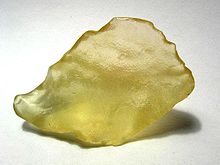Libyan desert glass
The amorphous quartz glasses known as Libyan Desert Glass , or LDG (from English L ibyan D esert G lass ) or LDS (G) ( English L ibyan D esert S ilica ( G lass) ) are found in the southwest of the large sandy lake , which extends from Libya extends into Egypt .
Emergence
It is usually assumed that the glasses were made with a high degree of probability when a meteorite hit , which is said to have fallen in North Africa around 28 to 30 million years ago. At high pressure and temperatures, the then superficial sandstone was melted and the liquid melt was thrown away. With rapid cooling in the flight phase, glass could be formed. An impact crater has not yet been found.
An alternative theory suggests that a hydrovolcanic explosion brought SiO 2 gel to the earth's surface. Volcanic activities, as they are known from the so-called Clayton craters, are documented in large parts of the north-eastern Sahara .
The desert glass consists of 98% lechatelierite , a natural quartz glass . Inclusions of baddeleyite , which emerges from zirconium sand at temperatures of over 1700 ° C , as well as traces of the meteorite (up to 0.5%) could be detected, which excludes a likewise discussed formation as a deposit of a lake enriched with dissolved silicon dioxide . The desert glass is counted among the impact glasses as it differs from the tektites in that it has up to 30 times more water inclusions of up to 0.16%.
history
Libyan desert glass was used as a tool or as an arrowhead as early as the Neolithic Age , and a twelve-centimeter hand ax from this era is exhibited in the Muséum national d'histoire naturelle in Paris . The relatively unspectacular appearance of the rare mineral has repeatedly led to confusion with conventional glass or ceramics over time. In 1922, Howard Carter considered the material of the scarab in the pectoral of the pharaoh Tutankhamun (Carter find number 267d, Egyptian Museum, inv.no. JE 61884) to be chalcedony , a type of quartz .
It was the English geologists Patrick A. Clayton and Leonard James Spencer who scientifically recorded LDSG for the first time in 1932, collected larger quantities and published the results of the investigation in 1933.
In 1998 the Italian mineralogist Vincenzo de Michele finally succeeded in using a refractometer examination to prove that the scarab of Tutankhamun's pectoral is also a cut piece of Libyan desert glass.
Features and description
The color of the Libyan desert glass varies from light yellow, honey yellow, green yellow, milky white to black gray. Specimens found on the surface of the earth are often polished by the desert sand ( wind grinding ), whereas those stuck in the earth are eaten away and dull. The hardness according to Mohs is 6 to 7, the density is 2.2 g / cm³, the fracture is conchoidal and the melting temperature is about 1700 ° C.
Chemical composition:
- 97.92% SiO 2
- 1.37% Al 2 O 3
- 0.02% K 2 O
- 0.37% FeO
- 0.05% MgO
- 0.21% CaO
- 0.26% Na 2 O 3
- 0.19% TiO 2
Occurrence
The scattered area in the Libyan-Egyptian desert covers about 6500 km² and is located between the large sand lake near the Koufra oasis in southwest Egypt and the Gilf-el-Kebir plateau in the Egyptian-Libyan border area, which is partly a restricted military area. Shifting dunes there repeatedly release individual specimens of the desert glass. The total occurrence is estimated at around 1400 tons.
literature
- Patrick A. Clayton, Leonard James Spencer : Silica Glass from the Libyan Desert (Lecture November 9, 1933). In: Mineralogical Magazine , Volume 23 (1934), No. 144, pp. 501–508 ( full text online )
- Guy Heinen: Tektite. Witnesses to cosmic disasters . Self-published, Luxembourg, 1997 ( table of contents )
- Vincenzo de Michele (Ed.): Proceedings of the Silica '96. Meeting on Libyan Desert Glass and related desert events. July 18, 1996 Bologna . Edizioni Pyramids, Milan 1997 ( summary )
- Vincenzo de Michele: The “Libyan Desert Glass” scarab in Tutankhamen's pectoral . In: Sahara: preistoria e storia del Sahara . tape 10 , 1998, ISSN 1120-5679 , pp. 107-109 .
- Jeasn-Jaques Sers: Ver libyque . In: Théodore Monod (ed.): Désert libyque. Editions Arthaud, Paris 1994, ISBN 2-7003-1023-3 , pp. 187-197.
Web links
- Desert glass and the craters of the Eastern Sahara by Reinhart Mazur.
- The non-impact origin of the Libyan Desert Glass (LDG) by Norbert Brügge.
- The Tutankhamun pectoral
- Wiener Zeitung : Glass from the Sandsee ( Memento from April 19, 2005 in the Internet Archive )

